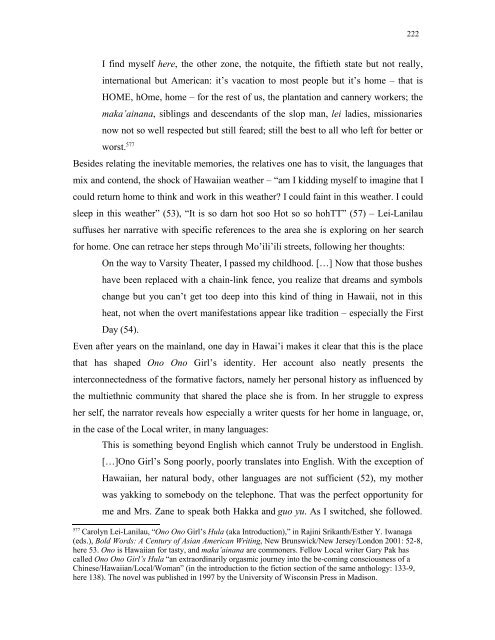A Paradise Lost - KOPS - Universität Konstanz
A Paradise Lost - KOPS - Universität Konstanz
A Paradise Lost - KOPS - Universität Konstanz
You also want an ePaper? Increase the reach of your titles
YUMPU automatically turns print PDFs into web optimized ePapers that Google loves.
I find myself here, the other zone, the notquite, the fiftieth state but not really,<br />
international but American: it’s vacation to most people but it’s home – that is<br />
HOME, hOme, home – for the rest of us, the plantation and cannery workers; the<br />
maka’ainana, siblings and descendants of the slop man, lei ladies, missionaries<br />
now not so well respected but still feared; still the best to all who left for better or<br />
worst. 577<br />
Besides relating the inevitable memories, the relatives one has to visit, the languages that<br />
mix and contend, the shock of Hawaiian weather – “am I kidding myself to imagine that I<br />
could return home to think and work in this weather? I could faint in this weather. I could<br />
sleep in this weather” (53), “It is so darn hot soo Hot so so hohTT” (57) – Lei-Lanilau<br />
suffuses her narrative with specific references to the area she is exploring on her search<br />
for home. One can retrace her steps through Mo’ili’ili streets, following her thoughts:<br />
On the way to Varsity Theater, I passed my childhood. […] Now that those bushes<br />
have been replaced with a chain-link fence, you realize that dreams and symbols<br />
change but you can’t get too deep into this kind of thing in Hawaii, not in this<br />
heat, not when the overt manifestations appear like tradition – especially the First<br />
Day (54).<br />
Even after years on the mainland, one day in Hawai’i makes it clear that this is the place<br />
that has shaped Ono Ono Girl’s identity. Her account also neatly presents the<br />
interconnectedness of the formative factors, namely her personal history as influenced by<br />
the multiethnic community that shared the place she is from. In her struggle to express<br />
her self, the narrator reveals how especially a writer quests for her home in language, or,<br />
in the case of the Local writer, in many languages:<br />
This is something beyond English which cannot Truly be understood in English.<br />
[…]Ono Girl’s Song poorly, poorly translates into English. With the exception of<br />
Hawaiian, her natural body, other languages are not sufficient (52), my mother<br />
was yakking to somebody on the telephone. That was the perfect opportunity for<br />
me and Mrs. Zane to speak both Hakka and guo yu. As I switched, she followed.<br />
577 Carolyn Lei-Lanilau, “Ono Ono Girl’s Hula (aka Introduction),” in Rajini Srikanth/Esther Y. Iwanaga<br />
(eds.), Bold Words: A Century of Asian American Writing, New Brunswick/New Jersey/London 2001: 52-8,<br />
here 53. Ono is Hawaiian for tasty, and maka’ainana are commoners. Fellow Local writer Gary Pak has<br />
called Ono Ono Girl’s Hula “an extraordinarily orgasmic journey into the be-coming consciousness of a<br />
Chinese/Hawaiian/Local/Woman” (in the introduction to the fiction section of the same anthology: 133-9,<br />
here 138). The novel was published in 1997 by the University of Wisconsin Press in Madison.<br />
222

















